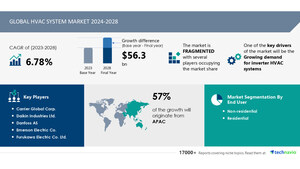NEW YORK, July 8, 2024 /PRNewswire/ -- The global oral cancer therapeutics market size is estimated to grow by USD 1.61 billion from 2024-2028, according to Technavio. The market is estimated to grow at a CAGR of 10.03% during the forecast period. Increasing incidence and prevalence of oral cancer is driving market growth, with a trend towards increase r and d of new drugs. However, side effects of chemotherapeutics poses a challenge. Key market players include Amneal Pharmaceuticals Inc., AstraZeneca Plc, Bristol Myers Squibb Co., Cipla Inc., Eli Lilly and Co., Endo International Plc, F. Hoffmann La Roche Ltd., Fresenius SE and Co. KGaA, GlaxoSmithKline Plc, Intas Pharmaceuticals Ltd., Lupin Ltd., Merck and Co. Inc., Pfizer Inc., Sanofi SA, Sun Pharmaceutical Industries Ltd., Takeda Pharmaceutical Co. Ltd., and Viatris Inc..
Get a detailed analysis on regions, market segments, customer landscape, and companies - Click for the snapshot of this report
Forecast period |
2024-2028 |
Base Year |
2023 |
Historic Data |
2018 - 2022 |
Segment Covered |
Product (Targeted therapy and Chemotherapy) and Geography (North America, Europe, Asia, and Rest of World (ROW)) |
Region Covered |
North America, Europe, Asia, and Rest of World (ROW) |
Key companies profiled |
Amneal Pharmaceuticals Inc., AstraZeneca Plc, Bristol Myers Squibb Co., Cipla Inc., Eli Lilly and Co., Endo International Plc, F. Hoffmann La Roche Ltd., Fresenius SE and Co. KGaA, GlaxoSmithKline Plc, Intas Pharmaceuticals Ltd., Lupin Ltd., Merck and Co. Inc., Pfizer Inc., Sanofi SA, Sun Pharmaceutical Industries Ltd., Takeda Pharmaceutical Co. Ltd., and Viatris Inc. |
Key Market Trends Fueling Growth
The oral cancer therapeutics market is witnessing significant growth due to the rising prevalence of oral cancer and the need for novel therapeutics for its treatment. While chemotherapy drugs are currently the primary treatment option, targeted therapies are gaining attention. For instance, Gliknik Inc.'s biropepimut-S (GL-0817) is a peptide immunomodulator in clinical trials for treating squamous cell carcinoma of the oral cavity. Other vendors, such as Celldex Therapeutics, Merck, and AstraZeneca, are developing targeted therapies and combination therapies, including cabozantinib, CDX-3379 and cetuximab, androgen deprivation therapy and pembrolizumab, and IMFINZI and tremelimumab, respectively. These therapies are in various stages of clinical trials for treating advanced head and neck squamous cell carcinomas, including oral cavity cancers. The focus on developing novel therapeutics and combination therapies will drive the growth of the oral cancer therapeutics market during the forecast period.
The Oral Cancer Therapeutics Market is witnessing significant growth due to increased research by institutions and healthcare organizations. Patient-centric approaches, telemedicine, and remote monitoring are trending in oral cancer treatment. The Oral Cancer Foundation and dental technology developments are playing a crucial role in early detection and diagnosis. The elderly population is at a higher risk, with root caries, mouth sores, and loss of appetite being common symptoms. Side effects like hair loss, nausea, and vomiting from treatments are concerns. Healthcare infrastructure development is essential for providing access to biopsies and imaging tests. Dental caries, smoking, human papillomavirus infection, and dentures pose risks. Advanced technologies like clinical trials for squamous cell carcinoma, verrucous carcinoma, Type 2 diabetes, oral leukoplakia, and erythroplakia are underway. The global geriatric population's growing footprint and the lack of dexterity in elderly patients necessitate innovative solutions. Oral cancer treatments are evolving, with hospitals and clinics, dentists, and ENT specialists collaborating to improve care.
Discover 360° analysis of this market. For complete information, schedule your consultation- Book Here!
Market Challenges
- Oral cancer therapeutics market growth may be hindered by the side effects of chemotherapeutics, which are a significant concern for patients. Common side effects include vomiting, nausea, mouth sores, joint and muscle aches, paresthesia, flushing, shortness of breath, urticaria (hives), rash, anaphylactic reactions, anemia, infection, sterility, secondary malignancies, diarrhea, ulceration, bleeding, and bone marrow suppression. These side effects can lead to patient discomfort and non-compliance with treatment. For instance, platinum-based chemotherapies, such as carboplatin, may cause hypersensitivity reactions in children. Taxanes (paclitaxel and docetaxel) can result in mouth sores, joint and muscle aches, paresthesia, flushing, shortness of breath, urticaria (hives), rash, and anaphylactic reactions. Alkylating agents (carboplatin) may lead to anemia, infection, sterility, and secondary malignancies. Antimetabolites (hydroxyurea and 5-fluorouracil) can cause diarrhea, ulceration, bleeding, and bone marrow suppression. These side effects may limit the market growth during the forecast period.
- The Oral Cancer Therapeutics Market faces several challenges. Inadequate healthcare infrastructure, especially in developing countries, hinders early detection and treatment. Dental caries and other oral diseases can mask oral cancer symptoms. The global geriatric population's expansion increases the risk of oral cancer. Advanced technologies for oral cancer treatments have a limited global footprint. Biopsies and imaging tests are essential for diagnosis but can be invasive and expensive. Risk factors like smoking, human papillomavirus infection, dentures, and lack of dexterity complicate treatment. Squamous cell carcinoma and verrucous carcinoma are common oral cancer types. Clinical trials for new treatments are ongoing for conditions like Type 2 diabetes, oral leukoplakia, erythroplakia, and HPV-related cancers. Hospitals and clinics, dentists, ENT specialists, and other healthcare providers play crucial roles in Oral Cancer Treatment. Surgery, radiation therapy, chemotherapy, targeted therapy, minimally invasive surgeries, and lifestyle modifications are common treatments. Tobacco consumption, alcohol consumption, and HPV infection are significant risk factors. Changing lifestyles and diagnostic techniques, imaging technologies, biomarker testing, and molecular diagnostics are essential for improving outcomes.
For more insights on driver and challenges - Download a Sample Report
Segment Overview
This oral cancer therapeutics market report extensively covers market segmentation by
- Product
- 1.1 Targeted therapy
- 1.2 Chemotherapy
- Geography
- 2.1 North America
- 2.2 Europe
- 2.3 Asia
- 2.4 Rest of World (ROW)
1.1 Targeted therapy- The oral cancer therapeutics market is experiencing significant growth due to the increasing number of oral cancer cases worldwide. Key players in this market include Merck & Co., Inc., Pfizer Inc., and Eli Lilly and Company. They are investing in research and development of novel therapies, such as targeted therapies and immunotherapies, to improve treatment outcomes and patient survival rates. Additionally, the rising awareness about early detection and screening is driving market growth. Overall, the oral cancer therapeutics market is expected to continue expanding in the coming years.
For more information on market segmentation with geographical analysis including forecast (2024-2028) and historic data (2018 - 2022) - Download a Sample Report
Research Analysis
Oral cancer, a type of head and neck cancer, is a significant global health concern. Treatment options include surgery, radiation therapy, chemotherapy, targeted therapy, and minimally invasive surgeries. Tobacco consumption and alcohol use are major risk factors, while human papillomavirus (HPV) infections and changing lifestyles are emerging causes. Diagnostic techniques, imaging technologies, and biomarker testing are essential for early detection. Molecular diagnostics and geriatric population research are key areas of focus due to the increasing elderly population. The Oral Cancer Foundation advocates for awareness and support. Dental technology developments offer new opportunities for prevention and treatment. Side effects of oral cancer therapies include hair loss, mouth sores, and loss of appetite. Root caries and pearl are less common but significant oral health issues related to oral cancer treatment. Despite advances, research institutions and healthcare organizations continue to explore new treatments and improve patient outcomes.
Market Research Overview
Oral cancer, a type of head and neck cancer, affects the lips, tongue, floor of the mouth, and other areas in and around the mouth. Treatment options include surgery, radiation therapy, chemotherapy, targeted therapy, and minimally invasive surgeries. Risk factors for oral cancer include tobacco consumption, alcohol consumption, human papillomavirus infection, and changing lifestyles. Diagnostic techniques, such as biopsies and imaging tests, are crucial for early detection. Advanced technologies, such as molecular diagnostics and biomarker testing, are also playing an increasingly important role. The geriatric population is particularly vulnerable due to the global aging population and the prevalence of dental caries, root caries, and other oral health issues. Healthcare organizations, research institutions, and patient-centric approaches are driving innovation in oral cancer treatment. Telemedicine and remote monitoring offer new opportunities for access to care. The Oral Cancer Foundation and dental technology developments are also contributing to advances in treatment and diagnosis. Side effects of oral cancer treatments, such as hair loss, mouth sores, loss of appetite, nausea, and vomiting, can be managed with proper care. Other risk factors, such as squamous cell carcinoma, verrucous carcinoma, clinical trials, Type 2 diabetes, oral leukoplakia, and erythroplakia, are also areas of ongoing research. The lack of dexterity in elderly patients and the use of dentures can present challenges in diagnosis and treatment. Hospitals and clinics, dentists, and ENT specialists are key players in the delivery of oral cancer care. Smoking and human papillomavirus infection are major causes of oral cancer, and prevention efforts are crucial for reducing the global footprint of this disease.
Table of Contents:
1 Executive Summary
2 Market Landscape
3 Market Sizing
4 Historic Market Size
5 Five Forces Analysis
6 Market Segmentation
- Product
- Targeted Therapy
- Chemotherapy
- Geography
- North America
- Europe
- Asia
- Rest Of World (ROW)
7 Customer Landscape
8 Geographic Landscape
9 Drivers, Challenges, and Trends
10 Company Landscape
11 Company Analysis
12 Appendix
About Technavio
Technavio is a leading global technology research and advisory company. Their research and analysis focuses on emerging market trends and provides actionable insights to help businesses identify market opportunities and develop effective strategies to optimize their market positions.
With over 500 specialized analysts, Technavio's report library consists of more than 17,000 reports and counting, covering 800 technologies, spanning across 50 countries. Their client base consists of enterprises of all sizes, including more than 100 Fortune 500 companies. This growing client base relies on Technavio's comprehensive coverage, extensive research, and actionable market insights to identify opportunities in existing and potential markets and assess their competitive positions within changing market scenarios.
Contacts
Technavio Research
Jesse Maida
Media & Marketing Executive
US: +1 844 364 1100
UK: +44 203 893 3200
Email: [email protected]
Website: www.technavio.com/
SOURCE Technavio

WANT YOUR COMPANY'S NEWS FEATURED ON PRNEWSWIRE.COM?
Newsrooms &
Influencers
Digital Media
Outlets
Journalists
Opted In





Share this article